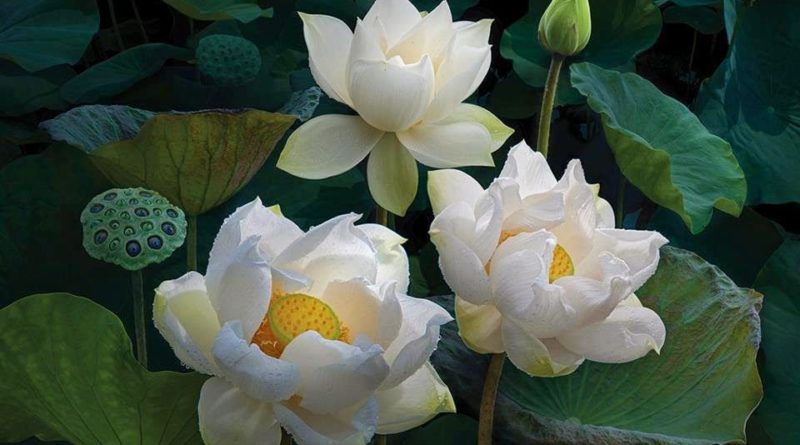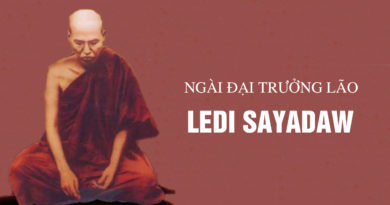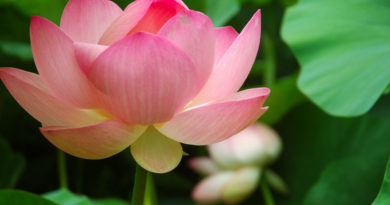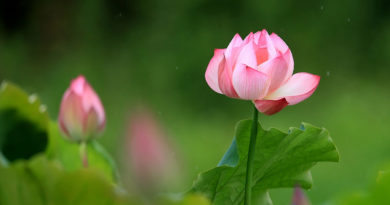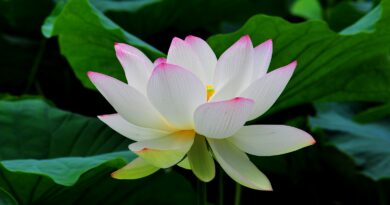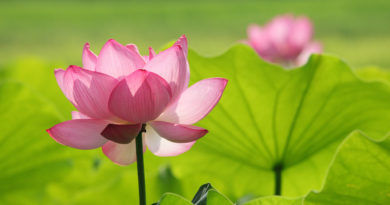BEYOND BEING AND NON-BEING
BEYOND BEING AND NON-BEING
From a talk given at Chithurst, U.K., during the winter retreat, February 1991
WHEN WE TALK ABOUT THE GOAL of Buddhist practice, about enlightenment or Nibbana, we use the term ‘realisation’ as being the most accurate way to approach it. Often one sees the term ‘getting’ enlightened, or ‘becoming’ enlightened; this is good and meaningful enough in ordinary speech but it also has connotations which are obstructive or misleading. Whenever we think of ‘getting’ something or ‘becoming’ something, it always implies that what there is right now is somehow lacking, there is ‘me’ that is missing something and I have got to get some kind of experience or some kind of quality that is going to make me complete in the future and then, once I have got it, it is going to be mine and I can keep it. There are many characters who have ‘got’ enlightened and then their enlightenment has wandered off and left them rather bereft and despairing for months or sometimes years.
So when we think and talk about enlightenment it is much better to use the word ‘realisation’, because it is pointing to the fact that we are discovering what is here already; we are realising, real-ising that which is already true, that which is the fabric and nature of our own being. Any thought of getting or becoming is what ties us to the incessant cycles of birth and death; this is what is called the bhavacakka, the cycle of becoming, because anything we get we can lose or we become anxious about being separated from–ownership is suffering. Thinking in terms of realisation, discovering the Truth, lends itself much less to the idea of ownership. The Dhamma, the ultimate reality of things, has no owner and this realisation of Truth is the fulfillment of our life. You do not have to take this as a proclamation, but I would say that this is the goal, the fulfillment of our life. Everything else that happens in life that we achieve or create, bring forth into the world, these are all secondary to the realisation of Truth, to this quality of seeing and being Dhamma.
Knowing the reality of things does not seem like very much. Our worldly tendencies and our habits of seeing always tend to focus on the objects, beings and places, the achievements, triumphs and disasters of our lives as being the real, substantial, important aspects, and something as ephemeral or intangible as realising Truth, on a conceptual level at least, seems a bit flimsy and simple-minded.
Buddhism gets criticised a lot by people who take the position of life affirmation. This has been the case right from the very beginning when the Buddha first started teaching–particularly because of being a religious tradition with a monastic order of celibate monks and nuns. This renunciant lifestyle gets quite a pounding from people, who are not necessarily worldly or indulgent, but just those who see value in the fulfillment of life on the worldly plane: the qualities of a loving relationship, of having children, of creating music or beautiful things, planting gardens, trees, building houses, forming friendships, creating new networks of wholesome activity, learning, teaching, nursing, healing the sick, helping the dying–these are all tremendously appealing, important and positive things in life. There is something very deep, very instinctual in our hearts which does appreciate and celebrate this–that loves life, that wants to live, to laugh, to love–and this seems to be the very fabric and essence, the spice and purpose of life, to live life to the hilt, to the full.
In the last ‘Inquiring Mind’, a Buddhist newspaper put out in America, they had an article about Ajahn Sucitto and Ven. Vipassi teaching a retreat in Massachusetts. This article went to great lengths to make sure that people knew that both these monks had lived very ‘full’ lives before they became monks; which is a polite way of saying you have done everything you could think of and then some before you became a monk. People are very scared of the idea that you would become a monk before you had really done everything, tried everything out. The idea is that life is to be lived, everything is to be tasted, to be experienced–Rajneesh was very keen on this kind of practice: doing absolutely everything to the limit and learning from that. The true learning experience in life is described as to take it all on, to swallow it whole and watch the results–so this does make what we do here at this monastery look a bit strange! Maybe I am sounding like an advert for Dionysiac hedonism ( brandy will be served in the kitchen after the evening meeting), but it is a very powerful streak in our minds, it strikes a powerful chord.
The other day I ran across something that D.T. Suzuki wrote in one of his books on Zen Buddhism, it went something like, “The spirit of freedom, which is the power behind Buddhism breaking through its monastic shell to ever more vigorously bring enlightenment to the masses, is the life impulse of the universe,” then he says something like, “The spirit of Buddhism has always been intellectual, moral and spiritual freedom, thus the moral aristocracy and the disciplinary formalism of primitive Buddhism could not bind our freedom, our spirit for very long,” so we are right out of the picture! I am not criticising D.T. Suzuki but just saying that there is a strong tendency in people’s minds to think, “Well, if you are living a very restrained, renunciant life you really must be missing out on a lot; you are not respecting all that life offers, these bodies are fertile, they are designed to produce offspring and you have creative talents–we can do, we can speak, we can create–why not!” Because I draw pictures for birthday cards for my family and occasionally write poems, I find that this is one of the few things about my life that my family can relate to. My mother is always encouraging me to create more masterpieces; I have got pads and pads of drawing paper and crayons and pens and ink, an incredible stash of stationery to do my creations on. I regularly get a burdened feeling when I look at this pile of stuff in my desk-drawer, “Oh dear, I suppose I should create something.” I like doing that kind of thing but one sees that for people with a perceptually based perspective on life, what you create becomes the most important thing-“After all, you can draw such nice pictures, you can say such nice things, why not? You are robbing the world by not producing offspring, poems, pictures, etc. etc. etc.”
This question had long puzzled me and struck me deeply when I first arrived at the monastery in Thailand. I was reminded of it this morning, since we have been having readings from ‘The Life of the Buddha’ and we have just got to the time of the Enlightenment. Oftentimes as a Westerner we think about enlightenment as meaning having a mind which is happy all the time, regardless of whatever is going on and whatever we choose to do–this is a very, very attractive proposition! After the Buddha’s enlightenment he sat for a week rapt in meditation, experiencing the bliss of deliverance and, after that absorption into bliss, he emerged and then what did he do? He spent the whole night contemplating Dependent Origination, the law of dependent arising: ignorance conditioning the arising of desire, attachment, birth, death, suffering and so forth; contemplating its arising, contemplating its cessation, backwards, forwards, up, down, all night long.
Now, if you were enlightened and had just become completely, irreversibly free from suffering, it’s possible to imagine you might think, “What a relief! At last that’s all over–no more suffering, marvellous, amazing.” And you might think, “Let’s go eat pancakes!” or “I wonder what that nice young lady who brought me the milk rice is doing tonight, maybe I’ll pop round and see her.” Or, if you were of a less sensual character, with a bit more nobility: “Now I’ll go back to my kingdom, encourage my old father, give him a bit of support and then help take over the kingdom and run a really good little country for the rest of my life.”
But we can see that, far from having this reaction, with his enlightenment the Buddha experienced life from a completely new dimension. He was seeing things in a way that he had not seen before, he was seeing what the rest of the world could not see. It’s rather like when we come into a new situation–an institution, a school or a family, a monastery–we are a stranger and we suddenly find ourselves in the midst of all kinds of webs of relationship, power-trips, struggles, gripes, loves and hates and personality conflicts going on; we are an outsider for whom all this has no value and yet to all the people involved in that place it’s all terribly real and important. We are not a part of it, however; we are not caught up in the value system.
One can also see enlightenment as simply growing up; as an adult one stops being able to play with dolls and toys in the same way that one did when one was a child, it becomes impossible. It’s also like having solved a puzzle that everyone else is still deeply involved in trying to unravel; you can see the answer, whereas everyone else is anguishing and fretting and rushing about and discussing how to find it. Or that lovely feeling of understanding a clue in a crossword–when you have got it and the letters all fit in the right places, “Ah, I see!”
At the enlightenment, the Buddha stepped out of the worldly perspective and could see from above the world–lokuttara. There is a wonderful passage in the scriptures that describes this insight of the Buddha and the way he saw things after his enlightenment: He saw that the worldly mind cherishes conditioned existence, it cherishes becoming; it opens itself to and welcomes conditioned existence, it welcomes becoming. The urge of the world, of worldly thinking, is always to become other: to get to the next thing, to progress, to develop, to have, to keep. It cherishes, relishes conditioned existence; but the problem is that what it relishes brings fear and what it fears is pain, because that which is the very basis of conditioned existence is also the basis of suffering.
This was the insight that he had with Dependent Origination–he saw how ignorance was the originator of all problems in life; how the reality that we give to our thoughts, feelings and emotions, to our memories and perceptions, is the true creator of all our difficulties. He also saw that if we believe in conditioned existence, if we believe in our suffering and we will possess it, we will own it, it will be ours. But with the ending of clinging, the ending of attachment, then suffering ceases.
This is perhaps a difficult insight to comprehend and really digest. In the same passage he says something like, “Liberation does not come through living conditioned existence but neither does it come through living non-existence. One who is liberated abandons craving for being without relishing non-being . . . .” Now where is that? You do not find that one in the ‘A-to-Z’! “Liberation comes from abandoning craving for being, without relishing non-being.”
The worldly mind can only see that either we are or we are not, something is or is not, but the Buddha is talking from a position which is neither this nor that, neither being nor non-being, neither existence nor non-existence. On hearing this sort of thing, maybe our mind starts to go into a flap, just goes blank or thinks, “What on earth is this about? I mean, come on, let’s be serious, let’s hear something useful, shall we!?” But from my perspective this is the most useful and powerful tool for insight that we have with which to understand and live our lives.
It is, however, something that is very intangible; conceptually it is not graspable, it evades our intellectual faculties. It is also the very reason why in his life the Buddha was constantly criticised for being a nihilist–because of not saying, “This is the Truth,” and stressing some kind of metaphysical pattern or grand cosmology. Instead he kept talking in terms of Nibbana, which just means ‘cooled’ or ‘blown out’, like the blowing out of a flame. Nibbana can also be translated as ‘extinction’ and to many people the concept seemed nihilistic. “Life has got to have a bit more to it than just extinction to look forward to!” But he refused to go along with the eternalists, people who were philosophically life-affirming, yet he also refused to go along with the annihilationists, those who were philosophically life-denying; he kept pointing at the fact that the Truth is other than either of those two fixed positions.
There is a lovely story from the Theravada tradition concerning a seeker called Kamanita. He, having heard of the Buddha’s reputation, was passing through Tajagaha on his way to meet him at Jeta’s Grove in Savatthi. At nightfall he put up in a potter’s house; little did he know at the time that the monk that he was sharing his lodging with that night was the Buddha himself.
Kamanita, after a while, started enthusiastically telling his fellow lodger how he was on his way to meet the Buddha. The Buddha sat there listening and didn’t let on who he was–“Tell me about this great master and his teaching,” he said. So Kamanita goes on for some time, telling the story of his own life and extolling all the wonders of the Buddha’s Dhamma, and how he teaches the path of bliss and eternal happiness.
Finally, he said, “Well, I’ve talked enough, you tell me about your life. What is you philosophy? Who is your teacher? What do you proclaim as the truth?” The Buddha started to speak, saying, “I will, in return for your narrative, unfold to you the doctrine of the Buddha.” He described the Four Noble Truths: the truth of suffering, the origin of suffering, cessation of suffering and the Path; and he expounded on anicca, impermanence, and anatta, selflessness. As he began, Kamanita was looking quite interested and taking it all in, but after a while he began to think, “This guy is a bit of a sourpuss . . . this isn’t the Master’s teaching as I understand it. Well, never mind, he’s got his right to think like he does.”
As the Buddha continued, Kamanita got more and more uncomfortable. All that this monk was saying to him seemed to hang together logically and it felt disturbingly right, but seemingly it had a horrible negative life-denying streak to it: all about extinction and cessation, and with no promise of “eternal and blessèd life” after death. His mind was still heavily programmed towards the idea of eternal happiness so, by the time the Buddha got on to anatta, Kamanita was decidedly agitated and did not know what to do. The monk’s exposition was obviously flawless but Kamanita’s heart was fixed on the fact that he must be wrong, so he thought, “What he is saying is all wrong! This is bad philosophy. The Buddha is the great teacher, he teaches absolute bliss for eternity. I am going to get the teaching directly from him. I should forget this guy, he really does not know what he is talking about.” The Buddha finishes speaking and sees that Kamanita is a bit agitated.
Finally, on a subdued tone Kamanita asks him, “Have you ever heard all this form the mouth of the perfect Buddha himself?”
At this point a smile plays around the Master’s lips.
“No, brother, I cannot say I have.”
Greatly relieved to hear this, Kamanita reassures himself that they will be able to meet the Buddha in person soon and that this monk’s mistaken and destructive conception of the Buddha’s teaching will be set straight.
Kamanita never realises his mistake–not until much later anyway, but that’s another story . . . . The Buddha, when asked about him, said, “Foolish as an unreasonable child was the pilgrim Kamanita, he took offence at the Teaching . . .”; in his lifetime his karmic obstructions were too dense to enable him to see what was right in front of him.
Ajahn Chah often said that this is a position that we find ourselves in–face to face with the Buddha, sharing a room together, spending hours and hours deep in conversation and never realising who this is. The truth of life is staring us in the face, but because we have already got programmed with something else that we want and expect, we are missing out on the lessons that life is actually able to teach us.
What we need to understand then, is what this knowledge was that the Buddha was pointing to. Firstly, it’s necessary to understand what we mean by the word existence–clinging to existence and clinging to being or non-being. The word ‘existence’ actually means ‘to stand out’; that which exists stands out, it protrudes, it is something which comes out, like a branch coming out of a tree. What the Buddha is pointing to is that, as long as we are talking in terms of existence or even non-existence (which is as if, instead of going out of the front door we have just gone out of the back door), both are taking a fixed position about some solid thing–there is still a separate ‘thingness’ there. What the Buddha is pointing to is that which does not come forth, that which is standing out, i.e. a condition of nature, mental or physical. What the Buddha is pointing to here is the Unconditioned, that which does not stand out, that which is not created, that which is not born of dying.
This is perhaps a bit hard to grasp but it is a very important point: as long as we are talking about something ‘existing’ it does not mean that that is the only reality. An experience is an excursion out from the Unconditioned through a pattern of events, back to the Unconditioned, like water rising from rivers and back to the sea. It is an excursion of existence; a lifetime is just an excursion, so is a thought–it is something which arises from the Unconditioned, from the space of the mind, and dissolves back into it again.
When something ‘exists’ it has a false independence, a false individuality, because at that time, it seems to be of a different and separate substance to all other things. When we believe in separate existence then we are giving solidity to that which is actually transparent, ephemeral, merely an element of the infinite patters of consciousness in the mind. So the Buddha is pointing to the Unconditioned as the basis for reality. The Buddha’s enlightenment was awakening to this Unconditioned nature of the basis of life; this was the dimension, the position from which he was seeing.
In this respect then, those aspects of life like that material, manifest world that we celebrate and which are so important, they become the basis for the realisation for the Unconditioned; the conditioned is needed in order to realise the Unconditioned. Through the agency of a human life and a human body, the Unconditioned can be realised. This process is a ripening or a transition, a transformation of the life spirit, the life force–the jivita. The conditioned, the green, is the infertile but becomes the basis for that which ripens into the gold, like a field of corn: the green of life ripens as the gold of wisdom, civilisation and true knowledge. The lokiya becoming the basis for the realisation for the lokuttara, these two always exist in relationship to each other and the transformation, the ripening of the one to allow the realisation of the other is what, in Buddhism, is called stream entry.
This is also called ‘the change of lineage’–when we see through our attachment to the body, to the mind, to ourself and to the world, it’s known as a change of lineage because, rather than looking upon our physical parents as our origin and the source of our being, we see that the true Origin of all is the Unconditioned mind. This is the source of all creation–as Thomas Merton puts it: “the living law that rules the universe is nothing but the secret gravitation that draws all things to God as to their centre. Since all true art lays bare the action of this same law in the depths of our own nature, it makes us alive to the tremendous mystery of being, in which we ourselves, together with all other living and existing things, come forth from the depths of God and return again to Him.”
So rather than placing ultimate value in the products and activities of the manifest, existent world, we learn to see that the saccadhamma–the Ultimate Reality of our own nature–is the source of all true value. When the need arises, we act, but when there’s no need we are still–and whether there is activity or not, the essential nature if the saccadhamma remains the same. It doesn’t have to prove its worth by taking a certain form, of any form at all; the sea is still the sea whether its rough or placid, gold still has the nature of gold whatever shape we make it. So, in this process of realisation we are affirming the very source of life–the Uncreated, Unconditioned–rather than making value judgments about waves or their absence on the surface. The source of our life is that source of the whole universe–the heart of the universe is your heart–so, far from the Buddha-Dhamma being a life-denying, negative philosophy, it is actually the most earth-shaking, silent roar of YES!!!–it is just avoiding making a fuss about the secondary details and attending to the essence instead. It is a philosophy of the ultimate aesthetic: “Truth is beauty–one who has arrived at Release truly knows what Beauty is.”
Bikkhu Amaro (1994), “Silent Rain”
Source: Budsas.org

